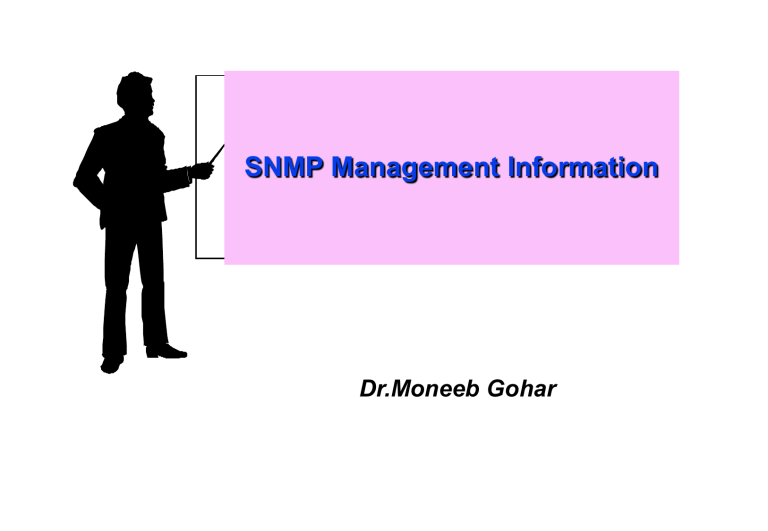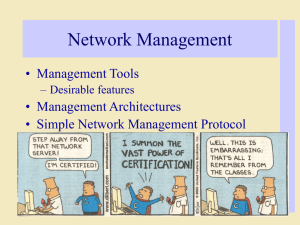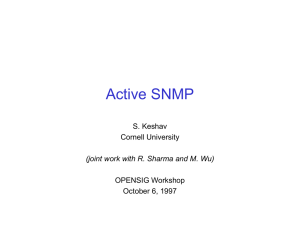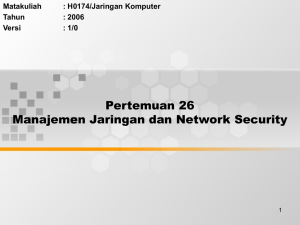
SNMP Management Information
Dr.Moneeb Gohar
SNMP Management Information
Database contains information about the elements to be managed : MIB
Each resource to be managed is represented by object
MIB : structured collection of such object having the form of tree
Structure of Management Information (SMI)
Specified in RFC 1155
Providing a standardized technique for defining the structure of a particular
MIB
Providing a standardized technique for defining individual objects, including
the syntax and the value of each object
Defining objects
MIB (Management Information Base)
a precise definition of the information accessible through a network
management protocol
each device must use the format for displaying information that is
defined by the MIB
RFC 1052
define an extended MIB for use with SNMP and CMIS/CMIP
is no longer realistic
RFC 1065: “Structure and Identification of Management Information
for TCP/IP based Internets (SMI)”
describe the syntax and type of information available in the MIB for TCP/IP
networks
RFC 1066
use the rules of the SMI
present the first version of the MIB for TCP/IP
known as MIB-I
MIB Structure
Leaf objects of the tree to be actual managed objects to represent
some resource, activity, or related information
Object identifier : a unique identifier for particular object type
Serving as name the object
internet OBJECT IDENTIFIER :: = { iso (1) org(3) dod (6) 1}
therefore, internet node’s object ID : 1.3.6.1
Object Syntax
Universal types
UNIVERSAL class of ASN.1 consisting of application-independent data
types for defining MIB objects
integer (UNIVERSAL 2)
octetstring (UNIVERSAL 4)
null (UNIVERSAL 5)
object identifier (UNIVERSAL 6)
sequence, sequence-of (UNIVERSAL 16)
Object ID consisting of sequence of integers
for example : object ID for tcpConnTable : 1.3.6.1.2.1.6.13
iso org dod internet mgmt mib-2
tcp
1
6
3
6
1
2
1
tcpConnTable
13
Defining Tables
The entire table represents a single instance of the object type
tcpConnTable.
Each row is an instance of the object type tcpConnEntry.
SNMP Overview
RFC 1156
allow for expansion of the MIB for vendor specific enhancement
RFC 1158
propose a second MIB (MIB-II)
extend the information base defined in MIB-I
Note: most network devices have software agent that support MIB-II and their own
private extensions
Each MIB would focus on a specific technology
RFC 1743: IEEE 802.5 Token Ring Interface type MIB
RFC 1757: Remote Network Monitoring MIB (RMON)
RFC 1513: FDDI Interface type MIB
RFC 1493: Bridge MIB
SNMP Overview
Object Identifier
ISO ASN.1 (Abstract Syntax Notation One) Syntax
a subset of ASN.1 defines the syntax for the MIB
use the tree architecture to organize all available information
–
labeled node
–
object identifier (OID) and sort text description
Root
Node (1)
Node (2)
Subtree
Node (1)
Node (2)
Node A (1)
Object (2)
Object (1)
Object A (1)
OID: 1.2.1.1 or
{node A 1}
SNMP Overview
Traversal of the MIB tree
root node
–
itu-t (0), administered by the ITU-T
–
iso (1), administered by the ISO
–
joint-iso-itu-t (2), jointly administered by ISO and ITU-T
•
internet: OID= 1.3.6.1 or {iso org(3) dod(6), 1}
ITU-T(0)
ISO(1)
joint-ISO-ITU-T (2)
…. org(3) …..
….. dod(6) …..
….. internet (1) …..
directory(1)
……
mgmt(2) ….
mib(1)
Experimental(3)
private(4)
enterprises(1)
SNMP Overview
directory (1)
–
reserved for future use
mgmt(2)
–
MIB-I originally assigned OID 1.3.6.1.2.1 or {mib 1}
–
MIB-I has been superseded by MIB-II
–
system(1): network device operating system
–
interfaces(2): network interface specific
–
address translation(3): address mappings
–
ip(4): Internet protocol specific
–
icmp(5): ICMP specific
–
tcp(6): transmission protocol specific
–
udp(7): user datagram protocol specific
–
egp(8): exterior gateway protocol specific
–
cmot(9): CMIP on TCP specific
–
transmission(10): transmission media specific
–
snmp(11): SNMP specific
SNMP Overview
experimental (3)
–
experimental protocols and MIB development intended to enter the standards
track
private(4)
–
used to specify objects defined unilaterally
–
enterprises(1) or {private 1}
•
•
•
an organization that has registered its own specific extensions to the MIB
vendor-specific MIBs are found
OID (1.3.6.1.4.1)
OIDs represent each manageable object with a unique sequence of numbers
and names
SNMP uses the number as an abbreviated form of the name
–
to make requests for data values
–
to identify each response that carries the values
SNMP Overview
The five SNMPv1message types (RFC1157)
Get-Request: retrieve information from device
Get-Response: agent responds to the Get-Request
Get-Next-Request: ask for the next specific object
Set-Request: for remote configuration parameter
Trap: an unsolicited message
Data Network
Managing host
station
MS-DOS
agent
agent
Host
agent
Terminal server
Router
agent
agent
Device
SNMP Overview
Format of SNMP
Version
Version
Version
Community
Community
Community
PDU
Request
0
Name X
0
type
ID
Get-Request, Get-Next-Request, Set-Request
PDU
type
PDU
type
Request Error
ID
status
Get-Response
Enterprise
Error
index
Agent Generic
addr
trap
Trap
Layer 7
SNMP
Layer 6
ISO presentation
Layer 5
ISO session
Layer 4
UDP
Layer 3
IP
Layer 2
ISO data link
Layer 1
Physical
Name X
Value X
……..
Value X
……...
Specific Time Name X Value X
trap
SNMP Overview
SNMP trap
an unsolicited message an agent sends to a station
inform the server about the occurrence of specific event
seven types of SNMP traps (MIB-II)
Managing host
–
coldstart of a system: reinitialing itself such that its configuration or protocol
has changed
–
warmstart of a system: reinitialing itself such that its configuration or protocol
has not changed
–
link down: a specific link has failed
Data Network
station
Device
agent
Link failure
Trap: interface #2, link down
SNMP Overview
–
link up: a specific link has come up
–
failure of authentication: a request does not provide proper authentication
–
EGP (Exterior Gateway Protocol) neighbor loss
• EGP is a reachability protocol used between data networks
–
enterprise specific
• a vendor to provide additional functionality that complements the generic traps
security
community string
–
station sends a particular password with each message
–
the password is referred to as the SNMP community string
SNMP Overview
Examples of an SNMP query
Managing host
station
Device
agent
Community
string: blee
SNMP Get, community string = blee
Communication string validated, SNMP Get-Response
Community string: blee
Managing host
Data Network
station
Device
agent
SNMP Set, community string= public
SNMP Trap, authentication failure


